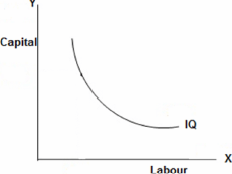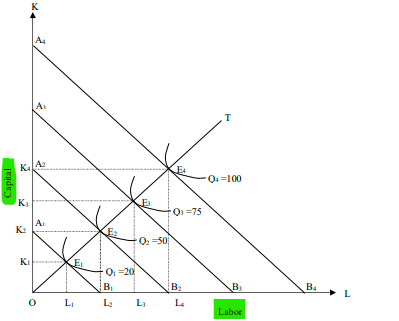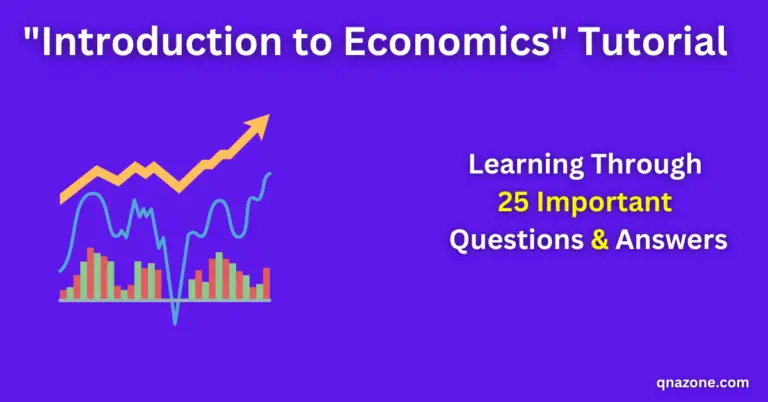50 Important Theory of Production Questions and Answers [With PDF]
The 7th chapter of our economics learning course is “Theory of Production.” In this article, we’ll learn the 50 most important “theory of production” questions and their answers.
These simple questions and answers will help you quickly understand the basic concepts of the theory of production, such as what production is, what is the theory of production, factors of production, production functions, the law of variable proportions, different types of iso-quant and iso-cost, returns of scale, and much more.
By reading this post, you can quickly prepare for economics courses and other competitive exams such as Vivas, job interviews, and school and college exams.
So let’s get started.
Theory of Production Questions and Answers
The 50 most important “theory of production” questions and answers are as follows:
Question 01: What is production?
Answer: In general, “production” refers to the process of creating a product. However, this is not the case in terms of economics. The term “production” has a specific meaning in economics.
In economics, “production” refers to the creation or enhancement of utility.
For example, man has increased the utility of things provided by nature by creating chairs, tables, and other furniture out of trees and clothing out of cotton.
Question 02: What is the theory of production?
Answer: The theory of production helps us understand how producers decide what the best course of action is given a set of cost constraints that a firm must deal with during the production process.
On the other hand, the theory of production explains how a company makes production decisions that minimize costs and maximize profits, as well as how the company’s production costs change with how much it makes.
Question 03: What are the factors of production?
Answer: All of the components that go into making a product is referred to as “factors of production.” The following are important production factors:
- Land
- Labour
- Capital
- Organization
Question 04: What is the land?
Answer: The first and most important component of production is the land. The term “land” generally refers to the earth’s surface.
However, it has a specific meaning when used in economics. The term “land” in economics only refers to the earth’s surface. “Land” in economics refers to all the resources that come from the natural world.
As a result, land includes land surface, soil fertility, light, air, heat, weather, climate, rainfall, rivers, streams, mountains, mines, forests, and fisheries, among other things.
Question 05: What are the features of the land?
Answer: The following are the key features of the land:
- The land is a natural gift that doesn’t require any work or skill to get.
- The supply of land is fixed and cannot be increased or decreased.
- The land is an infinite resource that can never be depleted.
- The land has primordial and imperishable powers.
- The land is a key factor in production.
- The land is versatile.
- The application of the principle of diminishing returns to land is obvious.
Question 06: What is labor?
Answer: In general, the term “labor” refers only to physical labor. However, in economics, the term “labor” has a broader meaning. In economics, labor refers to both physical and mental labor. Labor is a necessary component of production.
Question 07: What are the features of labor?
Answer: The following are the key features of labor in economics:
- Labor is the human component.
- Labor is a finite resource that cannot be sustained.
- Labor and workers are inextricably linked. That is, when going to work, the laborer must be present.
- Labor transferability is relatively low.
- Increases in labor wages frequently reduce rather than increase the labor supply.
- Labor can be both physical and mental in nature.
- Labor must be used in the manufacture of goods or the provision of services.
Question 08: What is capital?
Answer: Capital is another factor in production. In general, “capital” means money invested in a business.
However, in economics, capital is defined as a product used for further production. In other words, “capital” refers to the things that are made because of how well labor and land are used. These things are then used to make other things.
According to the modern economy’s definition of capital, capital includes not only money but also houses, buildings, machinery, furniture, and anything else used for production.
Question 09: What are the features of capital?
Answer: following are the key features of capital:
- Capital is a product that is used to fuel further production.
- The supply of capital can be increased or decreased.
- Capital depreciation occurs.
- Capital is highly transferable.
Question 10: What is the organization?
Answer: The organization is the fourth and final component of production. An organization is a person or group of people who plan and manage a business, acquire other means of production, engage in the business, pay their shares, and bear all of the business’s risks.
Question 11: What is the classification of production factors?
Production factors are divided into two categories:
- Fixed factors or inputs
- Variable factors
Question 12: What are fixed factors or inputs?
Answer: In economic terms, fixed inputs are those whose supply is inelastic in the short run.
As a result, in the short run, they are used in a fixed quantity.
Question 13: What are the variable factors?
Answer: In economics, the supply of a variable factor is elastic in the short run. These include labor, raw materials, and so on.
Question 14: What is the production function?
Answer: The production function is a set of rules that shows how the inputs and outputs of factors are related. It talks about the laws of proportion, or how the inputs (factors) change into the product (output) at any given time.
The production function can be written as an equation, with output as the dependent variable and inputs as the independent variables. The following is the equation:
Q =f(K, L)
Where,
Q = quantity of output
K = Capital
L = Labour
Question 15: What are the types of production functions?
Answer: There are two types of production functions:
- Short-run production function
- Long-run production function
Question 16: What is the short-run production function?
Answer: A “short run” is a period of time during which the quantities of one or more production factors cannot be changed. In other words, there is at least one factor that cannot be changed in the short run.
Question 17: What is the long-run production function?
Answer: The term “long run” refers to the period of time during which a company can change the quantities of all production factors, switching scales in the process. In the case of a long-run production function, all inputs are variables.
Question 18: What are the assumptions of the production function?
Answer: Some of the assumptions that the analysis of the production function is based on are:
- Both the input and the output are perfectly divisible.
- limited ability to substitute one factor for another because labor and capital are insufficient replacements.
- The state of technology is unchanging.
- The business maximizes the efficiency of its inputs.
- It has to do with a specific interval of time.
- If one of the variable factors changes, the level of output will also change.
Question 19: What is the method of production?
Answer: A production method is a set of the factors of production (or factor inputs) needed to produce a single unit of output.
Question 20: What is isoquant?
Answer: An isoquant is a place where all the combinations of production factors that lead to a certain level of output are found. An iso-quant, on the other hand, includes all technically effective ways to produce a good that yields a specific level of output.
Question 21: What are the key features of isoquant?
Answer: The following are the key features of isoquant:
- The isoquant slopes downward and to the right
- Higher isoquant indicates a higher production level
- The center of the isoquant is convex
- There can be no intersection of two isoquants.
Question 22: What is linear isoquant?
Answer: The linear isoquant model assumes that all production factors are perfectly substitutable. If all parts of production are interchangeable, one unit of a good can be made using only labor, only capital, or any combination of labor and capital.
Question 23: What is kinked isoquant?
Answer: The kinked isoquant curve indicates that the production factors are only partially interchangeable.
The isoquant’s kinks, which represent the fact that there are only a few production methods for each commodity, show how limited substitution is.
As a result, substitution is only possible at the kinks. This type of isoquant is called “activity analysis isoquant” or “linear programming isoquant” because linear programming is the main way it is used.
Question 24: What is input-output isoquant?
Answer: Input-output Isoquant says that the rate of substitution between two factors of production is zero because it assumes that the two factors work together perfectly. It implies that a commodity can only be produced using a single method.
Question 25: What is a convex isoquant?
Answer: The convex isoquant theory says that factors of production can keep substituting for each other up to a certain point, after which they can’t.

Question 26: What is the total product?
Answer: The total product is the sum of all the goods and services that a company makes with a certain number of inputs.
Question 27: What is the marginal product?
Answer: The marginal product is the amount by which the total product goes up when one more unit of a variable factor is used.
In other words, it shows how the total output keeps going up as more units of the variable factor are added.
marginal product = (difference in total products/difference in variable input)
Question 28: What is the average product?
Answer: The average product of a factor is the total output made per unit of the factor used. It can be obtained by dividing the total output by the total number of units of factor employed.
Average product = (Total product/Inputs of variable factors)
Question 29: What is the law of variable proportions?
Answer: The law of variable proportions shows how the production function looks when only one of the input factors changes and the rest stay the same.
Question 30: What are the assumptions of the law of variable proportions?
Answer: The law of variable proportions works under the following assumptions:
- It is assumed that technology will stay the same. If inventions lead to improvements in technology, the average, and marginal product may go up instead of down.
- It is assumed that some of the inputs have a fixed amount and some have a variable amount. This is one way we can change how the factor is put together and see how it affects the output. This rule doesn’t work when every factor is different.
- The variable factor’s units are all homogeneous.
- Consideration of the short-term economy.
Question 31: What are the different types of returns to a factor?
Answer: There are three types of returns to a factor, which are as follows:
- Increasing returns to factor.
- Diminishing returns to factor.
- Negative returns to factor:
Question 32: What are the increasing returns to factor?
Answer: Increasing returns to a factor means that when more and more units of a variable factor are added to a fixed factor of production, the output goes up by a larger percentage. In this case, the variable factor’s marginal product must be going up.
Question 33: What are the diminishing returns to factor?
Answer: Diminishing returns to a factor happen when the increase in marginal product from each additional unit of a variable factor starts to go down but stays positive.
Question 34: What are negative returns to factors?
Answer: Negative returns to factors are when an increase in a variable factor causes the total output to go down. As a firm’s variable inputs go up, the output changes in a negative way.
Question 35: What are the factors behind the law of returns?
Answer: One important thing that makes returns on a variable factor go up is that a fixed factor can’t be split up.
Every unit of a fixed factor, like capital, needs the best number of units of a variable factor. If the amount of variable factor used is less than what is best, the fixed factor isn’t being used to its full potential, which lowers the productivity of the variable factor.
Question 36: What are the limitations of the law of variable proportions?
Answer: The law of variable proportions has the following limits:
- It is not true that homogenous units of the variable input (especially labor) exist. Every worker or unit of labor is different from the others.
- In today’s world, it doesn’t make sense to think that prices for inputs and production methods will stay the same.
Question 37: What are the returns to scale?
Answer: Returns to scale are the changes in total output that happen when all of the factors of production change in a certain way. In this way, the relationship between inputs and outputs is tested by changing all the factors of production at the same time and in the same way.

Question 38: What are the types of returns to scale?
There are three different kinds of returns to scale, which are:
- Increasing returns to scale
- Constant returns to scale
- Diminishing returns to scale
Question 39: What are the increasing returns to scale?
Answer: Increasing returns to scale happen when a given percentage change in all production factors leads to a larger percentage increase in output.
Question 40: What are the reasons for increasing returns to scale?
Answer: There are many things that cause increasing returns to scale.
- Some inputs, like machinery, management skills, and so on, can only be used for a certain size of production. For example, the capital and the manager can’t be split up to fit a small production. Because they can’t be split up, these factors must be used in a minimum amount, even if the production scale is small. In this case, as a business increases its output, the cost per unit starts going down. This is what “increasing returns to scale” means.
- When people with specific skills are used, productivity per unit of inputs goes up. Because of this effect, increasing returns to scale happen.
Question 41: What are the constant returns to scale?
Answer: Constant returns to scale happen when the quantity of the factors of production is increased while keeping the ratio of the factors constant. Because of this, output goes up by the same amount as the number of factors of production.
Question 42: What is the cause of constant returns to scale?
Answer: Constant returns to scale are said to happen in productive activities where the factors of production are perfectly divisible. When all production factors are the same size, the production function is homogeneous to degree 1.
Question 43: What are the diminishing returns to scale?
Answer: “Diminishing returns to scale” describes a situation in which the number of production factors is increased while the proportion of those factors stays the same, but the output grows at a slower rate than the number of production factors has increased.
Question 44: What are the causes of diminishing returns to scale?
Answer: The main causes of diminishing returns to scale are:
- Diseconomies of scale are the root cause of diminishing returns to scale. It typically occurs as production size grows and managerial effectiveness declines, slowing the rate of output growth.
- The exhaustibility of natural resources is another factor causing diminishing returns to scale. For example, because coal deposits are limited, doubling the size of a coal mine may not double the amount of coal that can be mined.
Question 45: What is producer equilibrium?
Answer: Producer equilibrium is when a producer makes a certain amount of output by putting together the factors that cost the least.
Question 46: What is the iso-cost line?
Answer: The iso-cost line shows the different combinations of two production factors that a firm can buy with a certain amount of money. The isocost line is also called the outlay line or the line of equal costs.

Question 47: What is the shape of the iso-cost curve?
Answer: Iso-cost line is a straight line that intersects both axes (x and y). Line AB shows the iso-cost line. Line AB goes through all the different combinations of labor and capital that a company can buy for a certain amount of money at a certain price for each factor of production.

Question 48: What is the slope of the isocost line?
Answer: The ratio of input prices is shown by the slope of the iso-cost line.
Slope of the iso-cost line = (labor cost/capital cost)
Question 49: What causes a shift in the isocost line?
Answer: The iso-cost line will shift under two conditions:
- when the price of the factors remains constant but the company’s overall spending changes.
- when the factors’ spending remains constant while their prices change
Question 50: What is the least cost combination?
Answer: The term “least cost combination of factors” refers to a firm that, on the one hand, produces the greatest amount of output from a given level of inputs and, on the other hand, produces a given level of output at the lowest cost when the factors are combined in the best way possible.
I hope you have a good understanding of the “Theory of Production“ chapter by the end of this post.
If you read these 50 important “theory of production” questions and answers on a regular basis, you will gain a better understanding of the chapter.
Don’t forget to leave a comment for us if you have any questions or if you would like to find out more information.
You can also read:
- Introduction to Economics Questions and Answers [With PDF]
- Important Concepts of Economics Questions and Answers [With PDF]
- Important Theory of Consumer Behavior Questions and Answers [With PDF]
- Important Basic Elements of Demand Questions and Answers [With PDF]
- Important Basic Elements of Supply Questions and Answers [With PDF]
- Important theory of cost questions and answers [with PDF]






